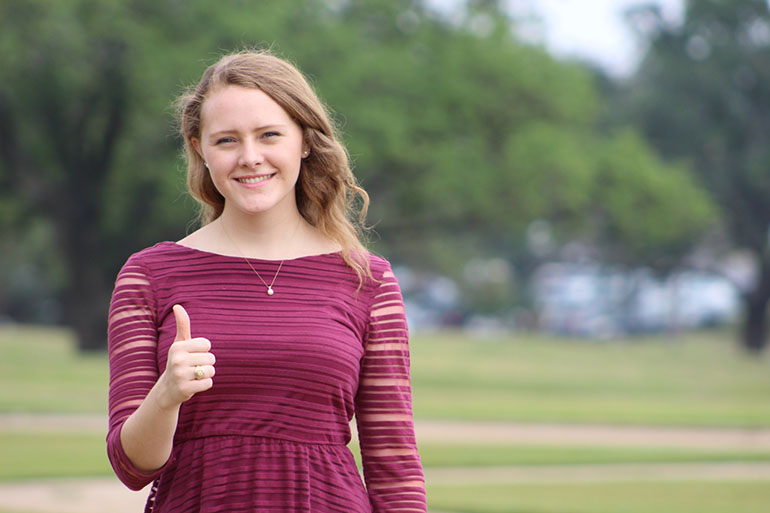
Engineers have made modern technology increasingly easier to operate for the common person. For Stephanie Wilcox, an undergraduate student in the Department of Electrical and Computer Engineering at Texas A&M University, knowing how to operate the technology was never enough.
As a seven-year-old, Wilcox took apart a radio for the first time. She was intrigued that a person could be familiar with a device and have no idea how all of the components interacted or how it was made. She has never stopped trying to understand the intricacies of technology since.
This passion for technology led Wilcox to pursue a degree in electrical and computer engineering and actively pursue three different research projects and lead the Institute of Electrical and Electronics Engineers (IEEE) student chapter at Texas A&M as the vice technology officer.
As a freshman, Wilcox got involved in research for design and production at Texas A&M Engineering Experiment Station’s initiative with Hand 2 Mind, a company that has provided hands-on learning curriculum for more than 40 years.
“Undergraduate research is so important. That opportunity alone allowed me to realize that I wanted to go into research and development,” said Wilcox. “I enjoyed the challenge of meeting a demand while working around the constraints of the client.”
During her sophomore year Wilcox participated in the 2015 AggiE_Challenge, the Texas A&M College of Engineering program designed to actively engage undergraduate students in multidisciplinary team projects related to the engineering challenges facing our society. Over the course of a year her team developed a 3-D printed biomimicry model for cancer research under the advisement of Dr. Akhilesh Gaharwar, assistant professor in the Department of Biomedical Engineering, and several graduate students. The project provided a new opportunity for drug discovery and personalized medicine for cancer treatment.
“Although my previous research was in a different area of engineering I was able to use the knowledge that I had acquired from operating and repairing 3-D printers the summer before and applied it to this very different field,” said Wilcox.
The same year, Wilcox received an Undergraduate Student Research Grant. Under the leadership of Dr. Arum Han, professor in the electrical and computer engineering department, she helped develop a microfluidic screening platform for studying the synergistic effect of temperature on microalgal growth for microalgal biofuel applications.
“An easy way to explain microfluidics is to think of a bottle in which you have water and oil. When you shake the bottle, little droplets of water are suspended in the oil,” said Wilcox. “With microfluidics you use this principle to create single-cell culture chambers within each droplet allowing you to control and manipulate the environment to which each cell is exposed.”
The multidisciplinary research allowed Wilcox to apply electrical engineering components to other fields of research. She created the platform on which the microfluidic system was laid. Typically when experimentation is done, individual petri dishes are used to control the environment entirely. When microfluidics is used to do single cell suspension all factors can be controlled on a microscale. This method is cheaper and faster.
In 2016, Wilcox was elected vice technical officer of the Texas A&M student chapter of IEEE. She has helped lead the technical education committee in organizing several C++, micro controllers, 3-D printing workshops and a miniMAKE Hackathon.
“These workshops allow students to learn and grow outside of the formal classroom and become engaged in engineering,” said Wilcox.
Wilcox will graduate in 2018 and is still exploring different opportunities within her field of study to learn how her interests fit into her plan.
“Follow your interests, even if you cannot see the current application and how it fits into your ‘plan;’ pursue it,” she said. “Each pursuit grants you the chance to discover new passions and learn more about yourself while providing an equally important opportunity to engage further in the world outside of your previous experiences and knowledge.”
Contributing author: Haley Posey